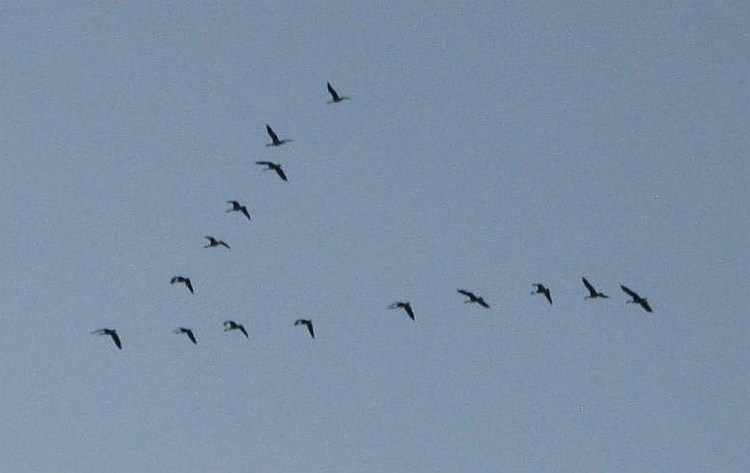The Canada geese, I think it is safe to say, are an emblem of autumn. Maybe spring, too, but in October their wedge-shaped gatherings low over the disrobing trees and stubble fields strike the eye with a different force of nature. “Mysterious, beautiful,” as W.B. Yeats said of their cousins, the wild swans. If you could directly perceive beauty itself, the nearest description you could give of it afterward might be Canada geese wheeling together in migratory flight. That would be October itself.
Where are they going? Their summer breeding grounds extend to the top of Canada, and winter grounds to Mexico. There’s also a range in between, which includes about the seaward half of Maine, where some of them aren’t going much of anywhere in October because they remain year-round. Canada geese mate for life, and when a goose who migrates pairs with one who did not learn it, the two settle in the year-round range.
These wrinkles in Canada goose life cycles aren’t things you can just casually spot with binoculars on October evenings. There’s a lot more going on than meets the eye.
How, for example, do migrating birds know the way from the northern breeding grounds hundreds, sometimes thousands of miles away to the winter range, and back again every year? The ornithologists have figured out some of what’s happening that you can’t see.
Migrating birds have a “map and compass” faculty they use to orient themselves to directions and to navigate. It combines information they pick up from their physical surroundings (which we see, too), from the sun (some of which we see and some of which we don’t), from stars, and from the Earth’s magnetic field (which we have no way of even knowing exists without instruments and mathematics).
Birds map their local environs using physical landmarks that help them find and remember, for example, the locations of nesting material, water and food. Not too surprising.
But the migratory flight, because of its distance, is obviously a different kind of problem. It turns out that at least some of them — European robins, for example — detect geomagnetic field lines that originate at the South Pole, curve upward around the Earth toward the equator and then back downward to return at the North Pole. The birds use these lines of energy and their inclinations to help them determine flight paths in the autumn and spring.
The researchers are pretty sure the birds’ perception of the magnetic field occurs in their eyes. (Research also indicates that homing pigeons, at least, somehow process information about magnetic fields in their beaks.) This raises a question — that maybe only backyard philosophers are allowed to say anything about since no scientists know the answer — about what the birds actually see. Does this biochemical activity in their eyes translate into some strange kind of vision that we can’t even guess about (the way we can’t really even guess what ultraviolet light looks like since our eyes don’t detect it, while many bird, insect and spider eyes do)? Anyway, the robins seem to detect magnetic fields in a fairly narrow range of intensity, since they get disoriented in stronger and weaker fields.
A second component of their compass faculty involves their ability to measure the sun’s position over the horizon. This is a fairly intricate process, because the sun’s altitude (height above the horizon) and azimuth (lateral position) vary not just by time of day, but by latitude. The sun is not in the same place in the sky at the same time in Bangor as in Philadelphia. And moreover, its arc across the sky shifts from day to day all year as it climbs, from December to June, and descends, from June to December. The birds nevertheless can locate themselves by measuring the sun’s azimuth — whatever “measuring” could possibly mean in bird experience.
Migrating birds also distinguish polarizations of light, which we don’t. Light waves travel at angles that are vertical, horizontal and otherwise to our eyes. Humans receive all the angles in roughly the same way, and experience it as glare. Polarizing sunglasses cut glare by filtering out the horizontal rays and letting in only the vertical rays. Migratory birds’ eyes sort out the angles naturally, and measure them, most effectively at sunset when the angles are most pronounced.
A third component of their compass is, amazingly, the stars. Night-migrating birds such as indigo buntings, European robins, bobolinks and garden warblers use Polaris, the North Star, to find north-south bearings. The researchers discovered this by showing young birds planetarium skies at different times and with different orientations. Birds who were shown a star ceiling revolving nightly around Polaris, as naturally occurs, found their migratory direction away from Polaris when released. Birds who were shown a star ceiling revolving around Betelgeuse, which is the bright star at the top of Orion in another part of the sky, flew away from Betelgeuse in the wrong direction. The researchers are pretty sure the birds locate Polaris through a visual recollection of star groupings, not by remembering isolated bright stars.
The birds combine all this information from the stars, sun, magnetic field and local surroundings to determine the migration route.
There are whole ranges of reality that we have no perceptual access to. But we have ways of figuring out they’re there. Kind of like the range of reality intimated by the astonished exhilaration you feel when a great broken chevron of Canada geese go flapping and racing on before the snow.
Dana Wilde lives in Troy. His new book, “Summer to Fall,” is available from North Country Press. You can contact him at naturalist1@dwildepress.net. Backyard Naturalist appears the second and fourth Thursdays each month.
Send questions/comments to the editors.




Comments are no longer available on this story